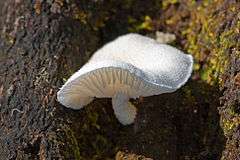Physalacriaceae
| Physalacriaceae | |
|---|---|
 | |
| Oudemansiella australis | |
| Scientific classification | |
| Kingdom: | Fungi |
| Division: | Basidiomycota |
| Class: | Agaricomycetes |
| Order: | Agaricales |
| Family: | Physalacriaceae Corner (1970) |
| Type genus | |
| Physalacria Peck (1882) | |
The Physalacriaceae are a family of fungi in the order Agaricales. Species in the family have a widespread distribution, ranging from the Arctic, (Rhizomarasmius), to the tropics, e.g. Gloiocephala, and from marine sites (Mycaureola) and fresh waters (Gloiocephala) to semiarid forests (Xerula).
Description
Most species in the Physalacriaceae form fruit bodies with caps and stipes. They have a monomitic hyphal system (wherein only generative hypha are produced), and clamp connections are present in the hyphae. Basidia (spore-bearing cells) are club-shaped with two to four sterigmata. The basidiospores generally have ellipsoidal, spindle-like (fusiform), cylindrical, or tear-drop (lacrimiform) shapes; they are thin-walled, hyaline, and do not react with Melzer's reagent.[1] The family also contains corticioid fungi (in genus Cylindrobasidium) and a secotioid species (Guyanagaster necrorhiza).[2]
Taxonomy
The family was originally defined by English mycologist E.J.H. Corner in 1970[3] and revised in 1985 by Jacques Berthier[4] but neither author anticipated the application to a molecularly defined group of agarics first identified by Moncalvo and others in 2002.[5] Molecular studies placed Physalacria, formerly the sole genus in this family, together with the agaric genera Flammulina and Xerula and Armillaria.[5][6][7][8]
Genera
- Armillaria
- Cylindrobasidium
- Cibaomyces
- Cribbea
- Cryptomarasmius
- Cyptotrama
- Dactylosporina
- Flammulina
- Gloiocephala
- Guyanagaster
- Himantia
- Hormomitaria
- Hymenopellis
- Laccariopsis
- Mycaureola
- Mycotribulus[9]
- Naiadolina
- Oudemansiella
- Paraxerula[10]
- Physalacria
- Ponticulomyces
- Protoxerula
- Pseudohiatula[9]
- Rhizomarasmius
- Rhodotus
- Strobilurus
- Xerula
See also
References
- ↑ Cannon PF, Kirk PM (2007). Fungal Families of the World. Wallingford, UK: CAB International. pp. 277–8. ISBN 0-85199-827-5.
- ↑ Henkel TW, Smith ME, Aime MC (2010). "Guyanagaster, a new wood-decaying sequestrate genus of Agaricales from the Guiana Shield". American Journal of Botany. 97 (9): 1474–84. doi:10.3732/ajb.1000097.
- ↑ Corner EJH. (1970). Supplement to 'A monograph of Clavaria and allied genera'. Beihefte zur Nova Hedwigia. 33. Lehre, Germany: J. Cramer. p. 10.
- ↑ Berthier J. Les Physalacriaceae Du Globe: (Hyménomycétales clavarioïdes). Bibliotheca Mycologica (in French). 98. Lubrecht & Cramer. ISBN 978-3768214247.
- 1 2 Moncalvo JM, Vilgalys R, Redhead SA, Johnson JE, James TY, Catherine Aime M, Hofstetter V, Verduin SJ, Larsson E, Baroni TJ, Greg Thorn R, Jacobsson S, Clémençon H, Miller OK (2002). "One hundred and seventeen clades of euagarics". Molecular Phylogenetics and Evolution. 23 (3): 357–400. doi:10.1016/S1055-7903(02)00027-1. PMID 12099793.
- ↑ Dentinger BT, McLaughlin DJ (2006). "Reconstructing the Clavariaceae using nuclear large subunit rDNA sequences and a new genus segregated from Clavaria". Mycologia. 98 (5): 746–62. doi:10.3852/mycologia.98.5.746. PMID 17256578.
- ↑ Wilson AW, Desjardin DE (2005). "Phylogenetic relationships in the gymnopoid and marasmioid fungi (Basidiomycetes, euagarics clade)". Mycologia. 97 (3): 667–79. doi:10.3852/mycologia.97.3.667. PMID 16392255.
- ↑ Hao YJ, Qin J, Yang ZL (2014). "Cibaomyces, a new genus of Physalacriaceae from East Asia". Phytotaxa. 162 (4): 198–210. doi:10.11646/phytotaxa.162.4.2.
- 1 2 Moreau, P-A., Vila, J., Aime, M.C., Antonín, V., Horak, E., Pérez-Butrón, J.L., Richard, F., Urban, A., Welti, S., Vizzini, A. (2015). "Cibaomyces and Cyptotrama, two new genera for Europe, and an emendation of Rhizomarasmius (Basidiomycota, Physalacriaceae).". Mycol. Progress. 14. doi:10.1007/s11557-015-1024-4.
- ↑ Qin J, Hao YJ, Yang ZL, Li YC (2014). "Paraxerula ellipsospora, a new Asian species of Physalacriaceae". Mycological Progress. 13 (3): 639–47. doi:10.1007/s11557-013-0946-y.